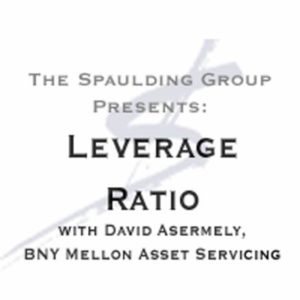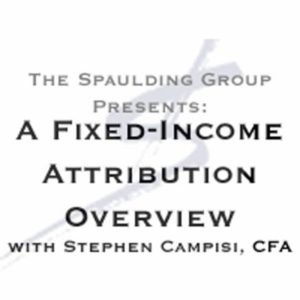Fundamentals of Performance Measurement – PLUS Virtual Training (ALL 5 Modules)
$1,295
Fundamentals of Performance Measurement – PLUS
ALL 5 Modules
Module 1 – ROR
Module 2 – ROR & Benchmarks
Module 3 – Performance Attribution
Module 4 – Risk
Module 5 – The GIPS® Standards
Fundamentals of Performance Measurement - PLUS
Virtual Training Modules
Virtual learning classes, approximately 4 hours each
All 5 Modules - $1,295
Module 1 - ROR
Instructor: David D. Spaulding, DPS, CIPM
May 18, 2020
10:00 AM - 12:00 Noon EDT
1:00 PM - 3:00 PM EDT
Learn the various formulas to derive performance; understand the impact of cash flows and learn about time- and money-weighting. Students also learn geometric linking, annualization, and much more.
- Why we measure performance the way we do.
- Insights into the history of rates of return, in general, and time-weighting, in particular.
- The history review will include a discussion on the contributions of Peter Dietz and the evolution of the approaches he developed, as well as those of the Bank Administration Institute, and the methods they developed and recommended.
- An in-depth discussion of both approximation and exact time-weighting methods, with examples and exercises.
- An introduction to the internal rate of return (IRR) and its different approaches.
- A discussion on what the differences are between time- and money-weighting, and when each should be used.
- A review of real-life examples to contrast time- and money-weighting, so that the students can better understand their strengths and shortcomings
- We will go over the mechanics behind compounding and why we compound the way we do.
- We will go over the ways to annualize rates of return, how we accomplish it over variable time periods, and the general rules surrounding its usage.
Module 2: ROR & Benchmarks
Instructor: David D. Spaulding, DPS, CIPM
May 19, 2020
10:00 AM - 12:00 Noon EDT
1:00 PM - 3:00 PM EDT
- We will review of examples where returns “don’t make sense,” and explain why this is the case, as well as why, in reality, they do (or don’t).
- We will spend time going into greater depth on the IRR.
- We discuss how to calculate gross- and net-of-fee returns, whether the fees are extracted from the account or paid separately.
- We will discuss the two main approaches to derive returns at the subportfolio level.
- We will discuss income accruals, for both interest and dividends. We will address why we accrue as well as how accruals are handled. We will provide examples of both.
- We will go over the different approaches to handle cash flows, and the impact they may have on the accuracy and appropriateness of the resulting returns.
BENCHMARKS: Gain the insights into the primary performance measurement benchmarks (indexes, peer groups, absolute, and custom) and the importance of each.
- We will review the general criteria used to assess benchmarks.
- We will discuss the various approaches to create market indexes, including the different approaches to weighting the underlying securities, as well as how to blend them.
- We will discuss the effects of turnover on indexes, the impact of security or sector concentration, and other concepts.
- We will discuss the benefits and shortcomings of peer groups, to include survivorship bias.
- We will spend time discussing absolute benchmarks, why and when they’re appropriate, as well as they’re advantages and disadvantages.
- We will discuss custom benchmarks and review an approach to create them.
Module 3: Performance Attribution
Instructor: John D. Simpson, CIPM
May 20, 2020
10:00 AM - 12:00 Noon EDT
1:00 PM - 3:00 PM EDT
Develop an appreciation and understanding of attribution.
- The class covers both absolute (contribution) and relative attribution, with most of the time spent on the latter.
- We explain why we measure attribution, and the benefits it provides.
- From an equity perspective, we will discuss and contrast the two major methods (Brinson-Fachler and Brinson, Hood, Beebower). Examples will be provided so that the students understand the impact of the subtle, but significant, differences between them.
- We will discuss the interaction effect, and why some firms prefer not to include it, and how this is done, as well as its benefits.
- We will review the three “laws” of relative attribution.
- We will discuss fixed income attribution, to include an explanation as to why such models are needed, by contrasting the fine points of equity and fixed income investing.
- An overview of the types of fixed income attribution models is discussed, as well as their uses, and implementation considerations.
- We will present and discuss a “Brinson-esque” fixed income model (McLaren), so students will better understand how these models can be employed to provide insights into the impact of manager decisions.
- We also cover the exposure-decomposition-based Campisi fixed income model that uses duration to help explain value added from bond manager decisions.
- We will discuss currency attribution, and review a naive approach to accomplishing it. And while we will briefly touch on Karnosky-Singer, due to time constraints we will not delve into great detail on this model.
- We will contrast arithmetic and geometric attribution, and the core differences between them, as well as their respective benefits and shortcomings.
- We will briefly contrast holdings and transaction-based attribution.
- We will explain the appropriateness of using daily vs. monthly attribution.
- We will briefly discuss the concept of multi-period attribution and touch on major approaches that can be employed to extend attribution across time. This discussion will also contrast geometric and arithmetic, and why arithmetic requires additional models to facilitate linking.
Module 4: Risk
Instructor: John D. Simpson, CIPM
May 21, 2020
10:00 AM - 12:00 Noon EDT
1:00 PM - 3:00 PM EDT
Learn the importance of risk measurement and the various formulas available. We begin by discussing risk, in general, and the reason it’s an important component of performance measurement, as well as the challenges in appropriately assessing risk.
- We give an overview of different types of risk that can be measured for investment portfolios.
- We review the major risk measures (e.g., standard deviation, downside deviation, beta, tracking error).
- We cover the concepts of correlation, covariance and the coefficient of determination (R-squared).
- We review capture ratios (up capture, down capture).
- We discuss various methodologies for estimating value at risk.
- We review the major risk-adjusted measures (e.g., Sharpe ratio, Treynor measure, Jensen’s alpha, Sortino ratio, Information ratio, Modigliani-Modigliani (M-squared)).
- We will discuss the advantages and disadvantages of the various measures (both risk and risk-adjusted).
- We review risk-adjusted measures for hedge funds (Calmar ratio, Sterling ratio, etc.).
- For each, where there are two or more approaches, we will review and contrast them.
- We close out the section by discussing risk management and monitoring, and why it’s important, as well as the challenges. We will also review an approach to managing risk.
Module 5: The GIPS® Standards
Instructor: David D. Spaulding, DPS, CIPM
May 22, 2020
10:00 AM - 12:00 Noon EDT
1:00 PM - 3:00 PM EDT
Establish fundamental knowledge about the Global Investment Performance Standards, its history, and its many concepts and requirements. The session will be based on the 2020 edition of the Standards.
- We begin with a discussion on the history of the Standards, to include an explanation as to why it was necessary to develop them, as well as how they’ve evolved over the past three decades.
- We discuss an approach to use to become compliant.
- We discuss the fundamental concepts of firm definition, composites, discretion, and dispersion. Other aspects of the Standards, such as minimum account size and composite creation date, are discussed.
- We discuss the importance of policies and procedures, and many of the topics that must be addressed.
- We discuss error correction guidance, and why firms may not want to employ all of the suggested levels.
- We review the different approaches to calculate composite returns.
- We go over the reporting requirements.
- We review what is meant by, and the role of, verification.
- We discuss the various approaches to measure dispersion.
- As to standard deviation, we explain how it can be used for both dispersion and volatility.
- We discuss fair value, and the various approaches to be employed to derive it.
- We discuss supplemental information, to include what it is and how to deal with it, as well as how it’s changed
- We review the advertising guidelines.
- We discuss the role of guidance statements.
Related products
-

A Framework for Risk Management of Hedge Funds – John Longo (webcast) Risk Week
$199 -

Futures and Forward Contracts: Accounting and Performance – Webcast
$150 -

Leverage Ratio with David Asermely of BNY Mellon Asset Servicing
$150 -

A Fixed-Income Attribution Overview with Stephen Campisi, CFA – Attribution week
$199

